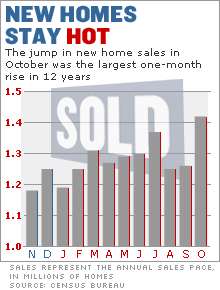 |
| Hot and cold home markets
|
| These real estate markets are the extremes: the fastest growing and the slowest. (Full story)
|
|
|
|
|
|
|
|
NEW YORK (CNNMoney.com) -
New home sales posted a surprising jump in October to the highest rate on record, according to a government report Tuesday that bucked other recent readings suggesting that the white-hot housing market has been cooling.
New homes sold at an annual rate of 1.42 million in October, the Commerce Department said, up from a revised 1.26 million pace in September. The 13 percent increase was the biggest percentage jump since April 1993.
Economists surveyed by Briefing.com had forecast that sales would slow to a 1.20 million rate.
The report follows earlier reports showing a drop in housing starts and building permits in October, as well as a bigger-than-expected decline in sales of existing homes and a drop in home builder confidence.
Most real estate economists have said that those readings all suggest the housing market has peaked and that rising mortgage rates are likely to slow sales from here. Some question whether the latest report isn't either an anomoly or even an example of sampling error.
"When you think you know what the market is doing, as I do, I look at this and say, 'Wow, at best I'm giving this a wait and see attitude,'" said David Seiders of the National Association of Home Builders. "I'd say the weight of evidence is still on that side of the market having topped out and beginning to cool."
The South, which got hit by major hurricanes in August and September, showed only a modest 1.9 percent rise in sales, while the West and Northeast both recorded more than a 40 percent jump in sales. Only the Midwest, where sales were off 9.5 percent from September, showed any signs of slowing.
There were some signs of cooling in new home prices in the report.
The median price, which is the price at which half of new homes sell for more and half sold for less, rose just 1.6 percent from September to $231,300.
Meanwhile, the average price fell from September, suggesting that new homes at the upper end of the market had shown more softness than middle- and lower-priced homes. That's surprising given that the higher-priced Northeast and West regions were the areas that showed the biggest bump in sales.
Perhaps more surprising, average prices slipped 1 percent from a year earlier while the median price rose just 1 percent over the same period, suggesting that builders are having to eat the increased costs of some building materials or are building smaller homes than in the past.
"A lot of time this price data reflects the mix of homes being sold rather than the price of one given type of home," said Phillip Neuhart, economist at Wachovia Securities.
Seiders added that if the sales are as strong as the report indicates, it could be driven by builders cutting prices or offering incentives to keep the sales going in the face of higher mortgage rates.
Higher mortgage rates
New home sales are a small part of the real estate market.
But they're also considered more of a leading indicator than sales of previously owned homes. New home sales are booked in the month when a sales contract is signed, while existing home sales are recorded when a sale is closed, typically a month or two after a contract is signed.
Mortgage rates have been rising, which raises the cost of financing and reduces the amount buyers can spend on a new home.
In October the average 30-year fixed rate mortgage was 6.07 percent, according to financing company Freddie Mac, up from 5.77 percent in September. October's average marked the first time it has been over 6 percent for a month since July 2004. Rates have since risen further, climbing to 6.33 percent in November, the highest since July 2002.
Rising rates can sometimes bring a rush of buyers into the market who hope to lock in rates before they rise any higher, so the spike in sales in October could represent that rush of buyers hoping to get in before mortgages made a new home purchase unaffordable, said Neuhart and Seiders.
"Is this a last gasp? Not necessarily. But is it a number that's sustainable? No," said Neuhart.
---
For more on the real estate market and what it means to you and your investments, click here.

|